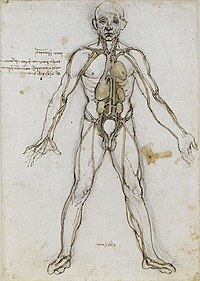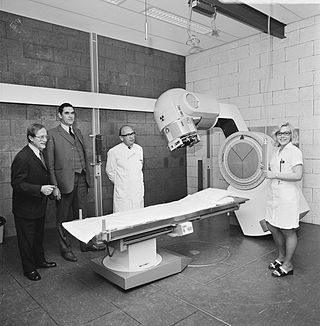This article needs additional citations for verification .(January 2017) |
This article contains a list of glands of the human body
Contents
 |
| Part of a series of lists about |
| Human anatomy |
|---|
This article needs additional citations for verification .(January 2017) |
This article contains a list of glands of the human body
 |
| Part of a series of lists about |
| Human anatomy |
|---|
| # | Name(s) | Location | Product | Structure |
|---|---|---|---|---|
| 1 | Apocrine sweat glands | skin | coiled tubular | |
| 2 | Bauhin's glands, anterior lingual glands | tongue, near tip | nonserous or mixed | |
| 3 | Brunner's glands, | duodenum | mucous | compound tubular |
| 4 | Bronchopulmonary glands | lungs | mucous | |
| 5 | Bulbourethral glands, Cowper's glands, Mery's glands | penis, base | Pre-ejaculate | tubulo-alveolar |
| 6 | Ceruminous gland | ear | Cerumen | |
| 7 | Ciaccio's glands, accessory lacrimal glands | eye | tears | |
| 8 | Cobelli's glands | esophagus, just above the cardia, in the mucosa | mucous | |
| 9 | Ebner's glands | tongue | serous | |
| 10 | Eccrine sweat glands | skin | coiled tubular | |
| 11 | Esophageal glands | esophagus | mucous | racemose |
| 12 | Exocrine pancreas | pancreas | serous | tubulo-acinar |
| 13 | Gastric chief cell, Wasmann's glands | stomach | serous | |
| 14 | Glomus coccygeum, coccygeal gland, Luschka's gland or gangliona | coccyx, near the tip | ||
| 15 | Goblet cells | digestive tract, respiratory tract | mucous | simple unicellular |
| 16 | Henle's glands | eyelids, in the conjunctiva | tubular | |
| 17 | Krause's glands | conjunctiva, middle portion | mucous | |
| 18 | Lieberkuhn's glands | intestines, surface of mucous membrane | digestive enzymes | simple tubular |
| 19 | Littré's glands, Morgagni's glands | spongy portion of the urethra | mucus | racemose |
| 20 | Lumbar glands | abdomen, near the back | ||
| 21 | Mammary gland | breast | milk | compound tubulo-acinar |
| 22 | Meibomian gland | eyelids | sebaceous | |
| 23 | Moll's glands | eyelids | sebum | |
| 24 | Montgomery's glands | mammary areola | sebaceous | |
| 25 | Naboth's glands | cervix and os uteri | mucous | |
| 26 | Olfactory glands, Bowman's glands | nose, olfactory region | mucus | |
| 27 | Paneth cells | small intestine | serous | |
| 28 | Gley's glands, Sandstroem's glands, parathyroid gland | in the neck | parathyroid hormone | |
| 29 | Parietal cell | stomach | hydrochloric acid, intrinsic factor | dynamic canaliculi |
| 30 | Parotid gland | mouth | saliva | tubulo-alveolar |
| 31 | Peyer's patches (or glands) | ileum, lymphatic glands | ||
| 32 | Prostate | surrounds the urethra just below the urinary bladder | tubulo-alveolar | |
| 33 | Pyloric glands | antrum of the pylorus, stomach | mucous, gastrin | simple branched tubular |
| 34 | Sebaceous gland | skin | sebum | acinar - branched |
| 35 | Sublingual gland, Rivini's gland | mouth | mucus (primarily) | tubulo-alveolar |
| 36 | Submandibular gland | mouth | mixed (M+S) | tubulo-alveolar |
| 37 | Sudoriparous glands, Boerhaave's glands | skin | ||
| 38 | Sigmund's glands | epitrochlear lymph nodes of axilla | ||
| 39 | Suzanne's gland | mouth, beneath the alveolo-lingual groove [1] | mucous | |
| 40 | Tiedmann's glands, Bartholin's glands, vulvovaginal glands | vulva, vagina | ||
| 41 | Tubarial glands | posterior nasopharynx, over the torus tubarius [2] | saliva | |
| 42 | Uterine glands | uterus | histotroph (uterine milk) | tubular |
| 43 | Weber's glands | tongue | mucous | tubular |
| 44 | Glands of Zeis | eyelids, free edges | sebaceous |
There are several specialized glands within the human integumentary system that are derived from apocrine or sebaceous gland precursors. There are no specialized variants of eccrine glands.
| # | Name | Precursor gland derived from [3] | Anatomic location |
|---|---|---|---|
| 1 | Ceruminous gland | Apocrine | Ear canal |
| 2 | Mammary gland | Apocrine | Breast |
| 3 | Moll's gland | Apocrine | Eyelid margin |
| 4 | Tyson's gland | Sebaceous | Genital skin |
| 5 | Meibomian gland | Sebaceous | Tarsal plate |
| 6 | Gland of Zeis | Sebaceous | Associated with eyelashes on eyelid margin |
| 7 | Montgomery gland | Sebaceous | Areola |
| 8 | Fordyce spot | Sebaceous | Vermillion border |

Exocrine glands are glands that secrete substances on to an epithelial surface by way of a duct. Examples of exocrine glands include sweat, salivary, mammary, ceruminous, lacrimal, sebaceous, prostate and mucous. Exocrine glands are one of two types of glands in the human body, the other being endocrine glands, which secrete their products directly into the bloodstream. The liver and pancreas are both exocrine and endocrine glands; they are exocrine glands because they secrete products—bile and pancreatic juice—into the gastrointestinal tract through a series of ducts, and endocrine because they secrete other substances directly into the bloodstream. Exocrine sweat glands are part of the integumentary system; they have eccrine and apocrine types.

Perspiration, also known as sweat, is the fluid secreted by sweat glands in the skin of mammals.
The excretory system is a passive biological system that removes excess, unnecessary materials from the body fluids of an organism, so as to help maintain internal chemical homeostasis and prevent damage to the body. The dual function of excretory systems is the elimination of the waste products of metabolism and to drain the body of used up and broken down components in a liquid and gaseous state. In humans and other amniotes, most of these substances leave the body as urine and to some degree exhalation, mammals also expel them through sweating.

The salivary glands in many vertebrates including mammals are exocrine glands that produce saliva through a system of ducts. Humans have three paired major salivary glands, as well as hundreds of minor salivary glands. Salivary glands can be classified as serous, mucous, or seromucous (mixed).

Sweat glands, also known as sudoriferous or sudoriparous glands, from Latin sudor 'sweat', are small tubular structures of the skin that produce sweat. Sweat glands are a type of exocrine gland, which are glands that produce and secrete substances onto an epithelial surface by way of a duct. There are two main types of sweat glands that differ in their structure, function, secretory product, mechanism of excretion, anatomic distribution, and distribution across species:

The male reproductive system consists of a number of sex organs that play a role in the process of human reproduction. These organs are located on the outside of the body, and within the pelvis.

Hidradenoma refers to a benign adnexal tumor of the apical sweat gland. These are 1–3 cm translucent blue cystic nodules. It usually presents as a single, small skin-colored lesion, and may be considered closely related to or a variant of poromas. Hidradenomas are often sub-classified based on subtle histologic differences, for example:

Mucoepidermoid carcinoma (MEC) is the most common type of minor salivary gland malignancy in adults. Mucoepidermoid carcinoma can also be found in other organs, such as bronchi, lacrimal sac, and thyroid gland.

Merocrine is a term used to classify exocrine glands and their secretions in the study of histology. A cell is classified as merocrine if the secretions of that cell are excreted via exocytosis from secretory cells into an epithelial-walled duct or ducts and then onto a bodily surface or into the lumen.
An apocrine sweat gland is composed of a coiled secretory portion located at the junction of the dermis and subcutaneous fat, from which a straight portion inserts and secretes into the infundibular portion of the hair follicle. In humans, apocrine sweat glands are found only in certain locations of the body: the axillae (armpits), areola and nipples of the breast, ear canal, eyelids, wings of the nostril, perineal region, and some parts of the external genitalia. Modified apocrine glands include the ciliary glands in the eyelids; the ceruminous glands, which produce ear wax; and the mammary glands, which produce milk. The rest of the body is covered by eccrine sweat glands.

Eccrine sweat glands are the major sweat glands of the human body. Eccrine sweat glands are found in virtually all skin, with the highest density in the palms of the hands, and soles of the feet, and on the head, but much less on the torso and the extremities. In other mammals, they are relatively sparse, being found mainly on hairless areas such as foot pads. They reach their peak of development in humans, where they may number 200–400/cm2 of skin surface. They produce sweat, a merocrine secretion which is clear, odorless substance, consisting primarily of water. These are present from birth. Their secretory part is present deep inside the dermis.
Sudomotor function refers to the autonomic nervous system control of sweat gland activity in response to various environmental and individual factors. Sweat production is a vital thermoregulatory mechanism used by the body to prevent heat-related illness as the evaporation of sweat is the body’s most effective method of heat reduction and the only cooling method available when the air temperature rises above skin temperature. In addition, sweat plays key roles in grip, microbial defense, and wound healing.
Skin appendages are anatomical skin-associated structures that serve a particular function including sensation, contractility, lubrication and heat loss in animals. In humans, some of the more common skin appendages are hairs, arrector pilli, sebaceous glands, sweat glands, and nails (protection).

Poromas are rare, benign, cutaneous adnexal tumors. Cutaneous adnexal tumors are a group of skin tumors consisting of tissues that have differentiated towards one or more of the four primary adnexal structures found in normal skin: hair follicles, sebaceous sweat glands, apocrine sweat glands, and eccrine sweat glands. Poromas are eccrine or apocrine sweat gland tumors derived from the cells in the terminal portion of these glands' ducts. This part of the sweat gland duct is termed the acrosyringium and had led to grouping poromas in the acrospiroma class of skin tumors. Here, poromas are regarded as distinct sweat gland tumors that differ from other sweat gland tumors by their characteristic clinical presentations, microscopic histopathology, and the genetic mutations that their neoplastic cells have recently been found to carry.
Porocarcinoma (PCA) is a rare form of skin cancer that develops in eccrine sweat glands, i.e. the body's widely distributed major type of sweat glands, as opposed to the apocrine sweat glands which are located primarily in the armpits and perineal area. This cancer typically develops in individuals as a single cutaneous tumor in the intraepidermal spiral part of these sweat glands' ducts at or near to where they open on the skin's surface. PCA tumors are classified as one form of the cutaneous adnexal tumors; in a study of 2,205 cases, PCA was the most common (11.8%) form of these tumors.

Spiradenomas (SA) are rare, benign cutaneous adnexal tumors that may progress to become their malignant counterparts, i.e. spiradenocarcinomas (SAC). Cutaneous adnexal tumors are a group of skin tumors consisting of tissues that have differentiated towards one of the four primary adnexal structures found in normal skin: hair follicles, sebaceous sweat glands, apocrine sweat glands, and eccrine sweat glands. SA and SAC tumors were regarded as eccrine gland tumors and termed eccrine spiradenomas and eccrine spiradenocarcinomas, respectively. However, more recent studies have found them to be hair follicle tumors and commonly term them spiradenomas and spiradenocarcinomas, respectively. Further confusing the situation, SA-like and SAC-like tumors are also 1) manifestations of the inherited disorder, CYLD cutaneous syndrome (CCS), and 2) have repeatedly been confused with an entirely different tumor, adenoid cystic carcinomas of the salivary gland. Here, SA and SAC are strictly defined as sporadic hair follicle tumors that do not include the hereditary CCS spiradenomas and heridtary spiradenocarcinoms of CCS or the adenoid cystic carcinomas.
A variant of eccrine spiradenoma which can be multiple on the scalp and can coalesce to form a 'Turban' tumour. In pathology, a cylindroma is a tumour with nests of cells that resemble a cylinder in cross section.

Acrospiromas are a broad class of benign cutaneous adnexal tumors. Cutaneous adnexal tumors are a group of skin tumors consisting of tissues that have differentiated towards one or more of the four primary adnexal structures found in normal skin: hair follicles, sebaceous sweat glands, apocrine sweat glands, and eccrine sweat glands. Acrospiromas are thought to derive from apocrine or eccrine sweat gland ducts near their acrosyringium, i.e. point where these ducts open to the skin's surface.

The Netherlands Cancer Institute (NKI) in Amsterdam was founded in 1913 by, among others, the surgeon Jacob Rotgans. The NKI, together with the Antoni van Leeuwenhoekziekenhuis, is formed into the NKI-AVL, which combines a scientific research institute with a specialized clinic focused on combating the disease cancer. Since 1973 the NKI is located next to the Slotervaartziekenhuis in Amsterdam. NKI is a member of EU-LIFE, an alliance of leading life sciences research centres in Europe.
The tubarial salivary glands, also known as the tubarial glands, are a pair of salivary glands found in humans between the nasal cavity and throat.